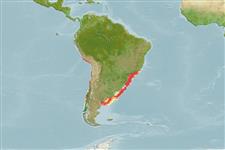Actinopterygii (ray-finned fishes) >
Perciformes (Perch-likes) >
Gempylidae (Snake mackerels)
Etymology: Thyrsitops: Greek, thyrsites, -ou = stalk of a plant, an ornament like a pine cone borne by Bacchus + Greek, ops = appearance (Ref. 45335).
Environment / Climate / Range
Ecology
Marine; benthopelagic; depth range 30 - 350 m (Ref. 36453). Subtropical, preferred 16°C (Ref. 107945); 15°S - 43°S, 77°W - 40°W (Ref. 6181)
Southwest Atlantic: off Rio de Janeiro (Ref. 47377), southern Brazil, Uruguay and Argentina. Southeast Pacific: off Chile.
Length at first maturity / Size / Weight / Age
Maturity: Lm ?, range 25 - ? cm
Max length : 40.0 cm SL male/unsexed; (Ref. 6181); common length : 25.0 cm SL male/unsexed; (Ref. 6181)
Mesobenthopelagic (Ref. 47377). Inhabits the continental slope (Ref. 6181). Feeds on small fishes (Ref. 6181) and euphausiids (Ref. 47377). Since 1980, no catches have been reported, except for 21 t caught in 1990 by Argentina (Ref. 6181). Good for smoked fish and fish and chips (Ref. 6181).
Life cycle and mating behavior
Maturity | Reproduction | Spawning | Eggs | Fecundity | Larvae
Nakamura, I. and N.V. Parin, 1993. FAO Species Catalogue. Vol. 15. Snake mackerels and cutlassfishes of the world (families Gempylidae and Trichiuridae). An annotated and illustrated catalogue of the snake mackerels, snoeks, escolars, gemfishes, sackfishes, domine, oilfish, cutlassfishes,. scabbardfishes, hairtails, and frostfishes known to date. FAO Fish. Synop. 125(15):136 p. (Ref. 6181)
IUCN Red List Status (Ref. 115185)
CITES (Ref. 94142)
Not Evaluated
Threat to humans
Harmless
Human uses
Fisheries: minor commercial
More information
ReferencesAquacultureAquaculture profileStrainsGeneticsAllele frequenciesHeritabilityDiseasesProcessingMass conversion
Tools
Special reports
Download XML
Internet sources
Estimates of some properties based on models
Phylogenetic diversity index (Ref.
82805): PD
50 = 1.0000 [Uniqueness, from 0.5 = low to 2.0 = high].
Bayesian length-weight: a=0.00724 (0.00365 - 0.01439), b=2.98 (2.80 - 3.16), in cm Total Length, based on LWR estimates for this species & (Sub)family-body (Ref.
93245).
Trophic Level (Ref.
69278): 3.9 ±0.63 se; Based on food items.
Resilience (Ref.
69278): Medium, minimum population doubling time 1.4 - 4.4 years (Assuming tm=2-4).
Vulnerability (Ref.
59153): Low to moderate vulnerability (34 of 100) .
